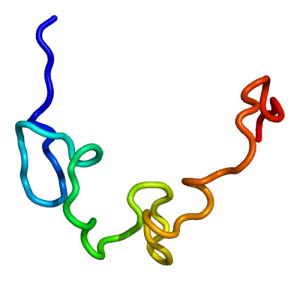 .
.
Lin28, a known player in cancer, is hard to suppress with drugs. But two related enzymes present highly druggable targets. (Emw/Wikimedia Commons)
In 2008, Gregory and his colleagues showed how a factor called Lin28, which is associated with numerous cancers, makes a cell more prone to revert to a less specialized, stem-like state.
Lin28 acts by preventing maturation of Let-7—an ancient family of microRNAs found in creatures from humans to worms. Let-7 is the yin to Lin28’s yang: it causes stem cells to differentiate (embryonic stem cells, which are completely unspecialized, have very low levels of it). If a cell’s Let-7 can’t mature, it can’t differentiate; instead, it remains stem-like and can potentially become cancerous.
Suppressing Lin28 with RNA interference (RNAi) has been shown to suppress tumor growth. But Lin28 is difficult to target with drugs. Gregory’s lab, part of the Stem Cell Program at Boston Children’s Hospital, has now identified two other key players that work in tandem with Lin28. Both are associated with loss of Let-7 and with tumors, but what’s exciting is that they are enzymes, presenting far more “druggable” targets.
In 2009, Gregory and colleagues showed that Lin28 recruits a type of enzyme known as a TUTase that comes along and adds a long “tail” of repeating uridine molecules to the immature Let-7. Now, in the journal Nature, they supply the final piece, showing that this UUU tail flags the proto-Let-7 for degradation by yet another enzyme called Dis312.Dis312 hasn’t been looked at systematically in cancer, but there’s one rare, highly lethal disease, known as Perlman syndrome, in which Dis312 is known to be mutated. Perhaps not coincidentally, Perlman is associated with fetal overgrowth and a predisposition to Wilm’s tumor, the most common form of renal cancer. Few people born with Perlman syndrome survive infancy.
Meanwhile, the team has shown in the journal Cell that when you use RNAi to suppress production of the TUTase, you can inhibit tumor growth. “That was a nice proof of principle,” says Gregory.
With funding from the National Cancer Institute, Gregory and colleagues will soon start screening some 5,000 small-molecule compounds to find ones that might block TUTase. Dis312 could eventually be tested in drug screens too, and if either search pans out, we could have a new weapon against cancer.
To learn more about Lin28/let-7 pathway collaboration opportunities at Boston Children’s, please contact Abbie Meyer, PhD, in the Technology & Innovation Development Office, [email protected]. To learn about supporting the research, please contact [email protected].






